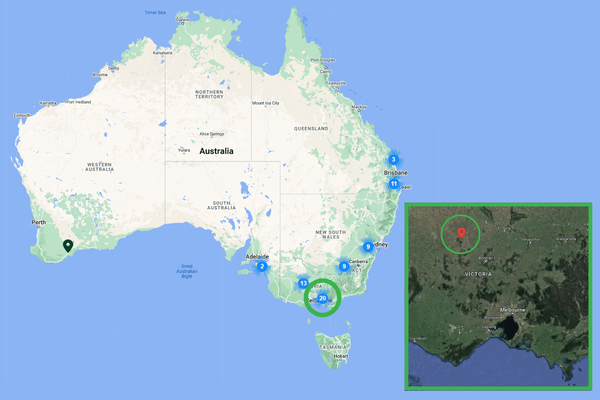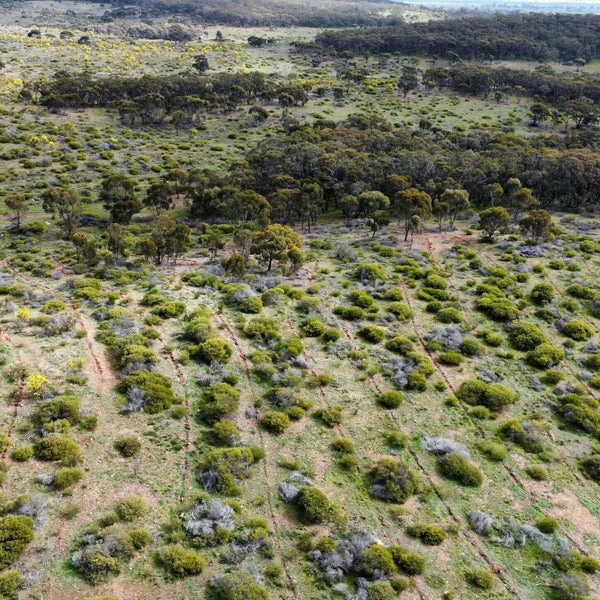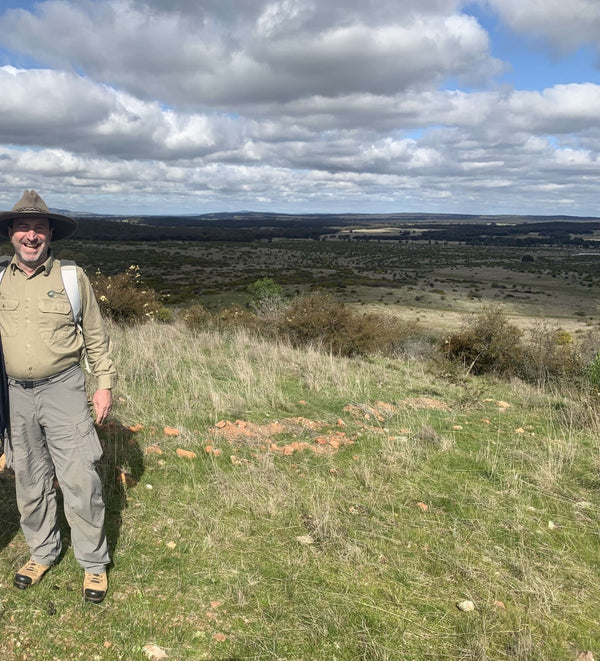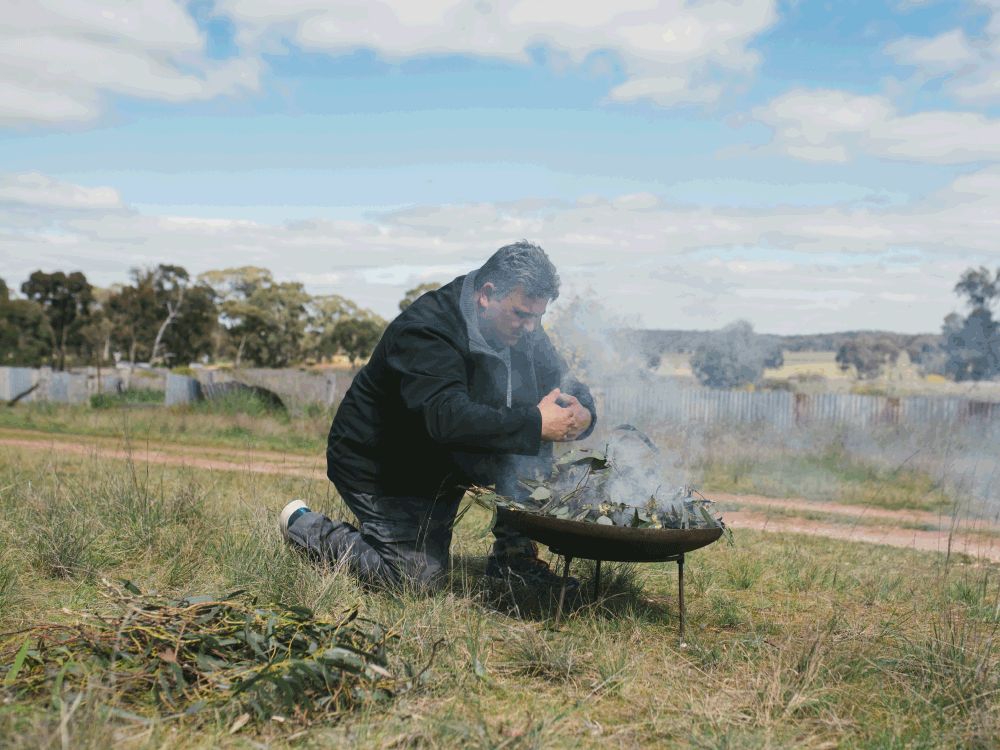Building Habitats & Restoring Country
Ngulambarra is located on Dja Dja Wurrung Country, north of Wedderburn in Central Victoria. It is a 340-hectare property located in an area previously cleared and heavily degraded by farming. Now, its restoration is resulting in the establishment of resilient, biodiverse ecosystems.
Situated between conservation properties at Ngarri-Mt Egbert in the east and the Lawan Reserve to the west, Ngulambarra forms a key piece of the Wychitella Biolink. Greenfleet is working with the Traditional Custodians of the land, the Djaara people, and Cassinia Environmental to restore the property, bolster the ecosystem and support wildlife to move through the area safely.
Site assessments throughout 2022 and 2023 demonstrate that the project is growing well, with canopy species establishing and forming an important part of the forest. With further planting undertaken in 2023, there are now 44 different species growing at Ngulambarra and building a native forest that will be legally protected for decades to come.

Location & map
Located north-west of Bendigo, Ngulambarra is situated approximately 3 hours from Melbourne.
As part of the Wychitella Biolink, the revegetation at Ngulambarra is improving biodiversity and building habitat for wildlife in the region.

Restoring Woodlands
Woodlands once covered large areas of south-eastern Australia. Since European settlement, one third of Australia’s woodlands have disappeared and Victoria has lost 83% of our woodland ecosystems to land clearing.
What remains is the most threatened wooded ecosystem in Australia. The birds, mammals and reptiles that inhabit these areas are in sharp decline, and the drier climate is threatening the remaining fragmented landscape.
Greenfleet’s Revegetation Approach At Ngulambarra
Between 2020 and 2023 nearly 240 hectares were revegetated with close to 100,000 native trees, including 60kg of seed that was sowed directly into the soil, and seedlings that were both hand and machine planted. These trees will grow to restore the native ecosystem in the area and increase overall biodiversity and resilience.
More than 40 native species were selected as part of the restoration at Ngulambarra. This included many wattle species, which are vital for the local birdlife, and a number of eucalypt species including yellow gum (Eucalyptus leucoxylon), which are helping form the forest canopy. The trunk of the yellow gums will eventually form tree hollows, which will provide vital habitat to a number of mammals and invertebrates. The flowers of this tree will also provide a food source to the local birds.
Throughout 2022 and 2023, Greenfleet’s ongoing site monitoring at Ngulambarra has demonstrated that this revegetation project is making great progress towards becoming a thriving, biodiverse forest. While it is still in its establishment phase, we expect that much of this project will become important habitat for native wildlife species in the coming years.

A visit in 2023 showed how some of the direct seeding had successfully germinated and was establishing well. Here, you can see Greenfleet's General Manager, Partnerships, Michael Coleman standing in front of part of the revegetation area. Only two years prior, this area was cleared grassland.
In 2023, further planting has taken place at Ngulambarra to include rare and declining plant species as part of the unique restoration work occurring at the site. Some of the species planted as part of this work include, Heath Myrtle (Micromyrtus ciliata), Rosy Baeckea (Euromyrtus microphylla) and Spiny Rice-Flower (Pimelea spinescens) a critically endangered species. These species will grow to diversify the ecosystem growing at Ngulambarra and help bolster the prevalence of these species in the region.
Enabling The Forest To Thrive
As well as our reforestation work, other activities have been undertaken to assist in the area’s restoration. In many parts of Central Victoria, there is an issue with the introduced wheel cactus (Opuntia robusta), which is an aggressive pest.
One solution is to individually stab each cactus with a herbicide so that they are unable to spread further. While it may sound like an unusual practice, cactus stabbing plays an important part in ensuring the native tree species we plant in the area have the best chance of survival.
Working With Djaara People To Restore Country
By working with the Traditional Owners on this project, we are working to support Djaara values, including through the active management of natural resources on site to ensure connection to Country, and to develop sustainable economic outcomes for their community.
As well as the areas revegetated to build a biodiverse forest, other areas of the site were planted with culturally significant food and fibre grasses. Buwatji (grasses used for grain) and Witji (weaving grasses) are among the indigenous grasses being grown at Ngulambarra.
Parts of the property have also been planted with native kangaroo grass (Themeda triandra) and yam daisy (Myrnong) with the goal of creating traditional food crops that are climate appropriate. Kangaroo grass is perennial, and its seeds can be harvested much like grain to be made into flour for products such as bread. As a native plant, it is resilient to drought and extreme variances in temperature, which is important in the Central Victorian climate. The seeds can also be used in a traditional ceremonial context and the Yam Daisy’s roots can be used as a vegetable in many dishes.
Additional benefits of growing these native grasses are that they are adapted to the nutrient composition of the soil. These perennial plants have deep root systems that help control soil salinity, which plays an important part in ecosystem health (SDG 15: Life on land), as well as sequestering carbon (SDG 13: Climate action).
On a site visit in 2022, Djaara man Jason Kerr, Welcomed the Greenfleet Team to Country and shared his knowledge about his family and the area. He also conducted a Smoking Ceremony, engaging the team in this traditional practice.
Creating Habitat Links
An important benefit of the revegetation work at Ngulambarra is the creation of protected habitat for many of the local wildlife species. Located between conservation properties at Ngarri-Mt Egbert in the east and the Lawan Reserve to the west, Ngulambarra forms a key piece of the Wychitella Biolink. By reconnecting parts of the Wychitella Biolink, this forest will help local wildlife move safely through the area to find habitat, food and breeding opportunities. Some of the species known to the area including lace monitors, quolls and the ground-dwelling mallee fowl.
Other native and endangered bird species can also be found here, including the swift parrot, shy heathwren and inland thornbill. Birds in particular will benefit from plant species such as wattles used in the restoration.
The forest at Ngulambarra will be protected for 100 years to ensure that it can grow to its full potential and provide a wealth of environmental benefits to the region for decades to come.
Location Size
340 hectares in Central Victoria
Planting Dates
2020, 2021, 2022, 2023
Species
Gold dust wattle (Acacia acinacea)
Grey mulga (Acacia brachybotrya)
Reed-leaf wattle (Acacia euthycarpa)
Wallowa (Acacia euthycarpa)
Broom wattle (Acacia genistifolia)
Lightwood (Acacia implexa)
Mallee wattle (Acacia montana)
Golden wattle (Acacia pycnantha)
Varnish wattle (Acacia verniciflua)
Buloke (Allocasuarina luehmannii)
Slaty sheoak (Allocasuarina muelleriana)
Drooping sheoak (Allocasuarina verticillata)
Sweet bursaria (Bursaria spinosa)
Chinese scrub (Cassinia arcuata)
Broom bitter-pea (Daviesia genistifolia)
Wedge-leaf hop bush (Dodonaea cuneata)
Wedge leaf hopbush (Dodonea viscosa spp cuneata)
Coccid emubush (Eremophila gibbifolia)
Berrigan (Eremophila longifolia)
Bull mallee (Eucalyptus behriana)
Yellow gum (Eucalyptus leucoxylon)
Yellow box (Eucalyptus melliodora)
Grey box (Eucalyptus microcarpa)
Red box (Eucalyptus polyanthemos)
Blue mallee (Eucalyptus polybractea)
Green mallee (Eucalyptus viridis)
Rosy baeckea (Euryomyrtus ramosissima)
Small-leaved mallee-pea (Eutaxia microphylla)
Sticky goodenia (Goodenia varia Sticky Goodenia)
Heath teatree (Leptospermum myrsinoides)
Moonah (Melaleuca lanceolata)
Broombush (Melaleuca uncinata)
Fringed heath-myrtle (Micromyrtus ciliata)
Sticky boobialla (Myoporum petiolatum)
Sugarwood (Myoporum platycarpum)
Yam daisy (Myrnong)
Silver daisy-bush (Olearia pannosa subsp. cardiophylla)
Grey everlasting (Ozothamnus obcordatus)
Spiny rice-flower (Pimelea spinescens ssp spinescens)
Weeping pittosporum (Pittosporum angustifolium)
Scarlet mintbush (Prostanthera aspalathoides)
Jagged mintbush (Prostanthera denticulata)
Snowy mintbush (Prostanthera nivea)
Sweet quandong (Santalatum acuminatum)
Kangaroo grass (Themeda triandra)
Sticky everlasting (Xerochrysum viscosum)



